Boyle J.A. The Cambridge History of Iran, Volume 5: The Saljuq and Mongol Periods
Подождите немного. Документ загружается.

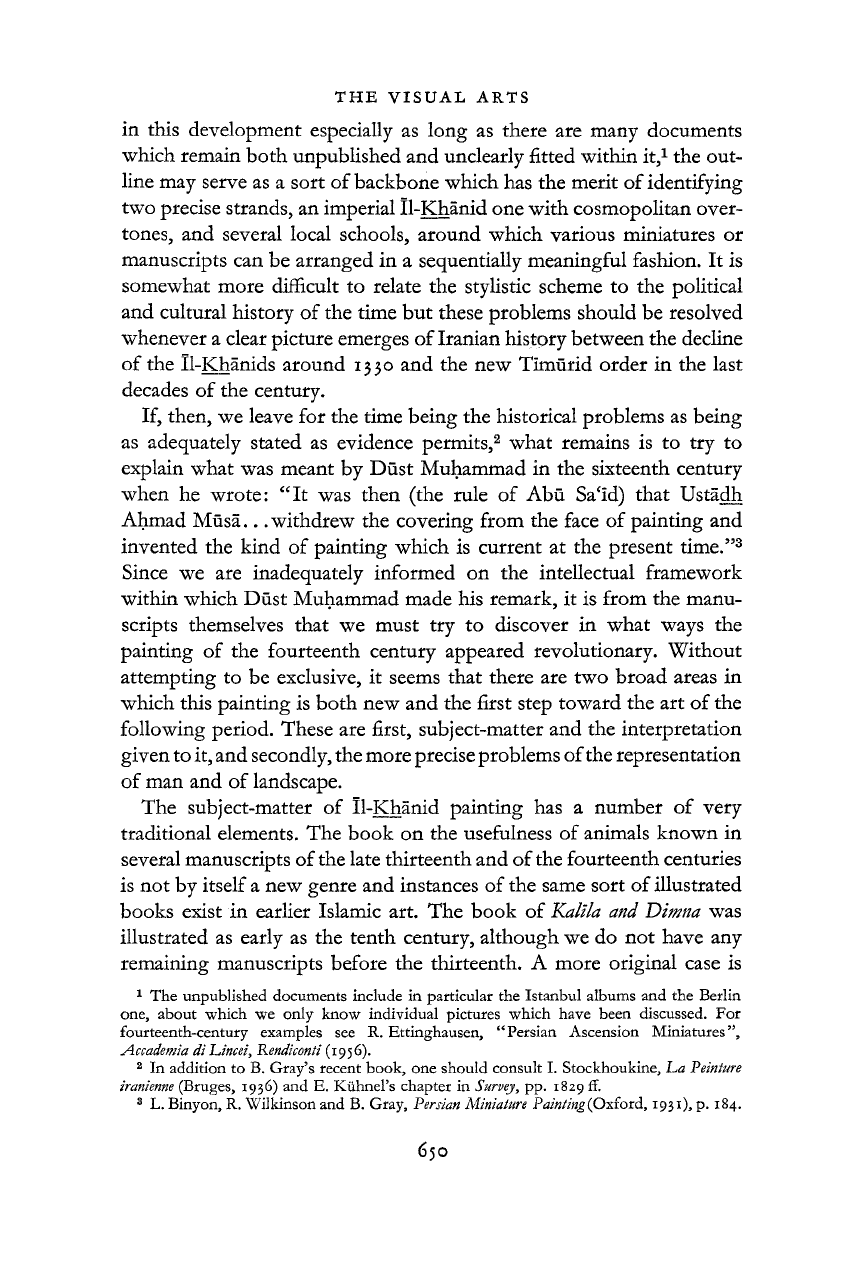
THE VISUAL ARTS
650
in this development especially
as
long
as
there
are
many documents
which
remain both unpublished
and
unclearly fitted within
it,
1
the
out-
line may serve
as a
sort
of
backbone which
has the
merit
of
identifying
two
precise strands,
an
imperial ll-Khanid one with cosmopolitan over-
tones,
and
several local schools, around which various miniatures
or
manuscripts
can be
arranged
in a
sequentially meaningful fashion.
It is
somewhat more difficult
to
relate
the
stylistic scheme
to the
political
and cultural history
of the
time
but
these problems should
be
resolved
whenever
a
clear picture emerges of Iranian history between
the
decline
of
the
Il-Khanids around 1330
and the new
Timurid order
in the
last
decades
of the
century.
If, then,
we
leave
for the
time being
the
historical problems
as
being
as adequately stated
as
evidence permits,
2
what remains
is to try to
explain
what was meant
by
Dust Muhammad
in the
sixteenth century
when
he
wrote:
"It was
then
(the
rule
of Abu
Sa'Id)
that
Ustadh
Ahmad
Musa.. .withdrew
the
covering from
the
face
of
painting
and
invented
the
kind
of
painting which
is
current
at the
present time."
3
Since
we are
inadequately informed
on the
intellectual framework
within which Dust Muhammad made
his
remark,
it is
from
the
manu-
scripts themselves
that
we
must
try to
discover
in
what
ways
the
painting
of the
fourteenth century appeared revolutionary. Without
attempting
to be
exclusive,
it
seems
that
there
are two
broad areas
in
which
this painting
is
both
new and the
first step toward
the art of the
following
period. These
are
first, subject-matter
and the
interpretation
given
to it, and
secondly,
the more precise problems
of
the representation
of
man
and of
landscape.
The
subject-matter
of
Il-Khanid painting
has a
number
of
very
traditional elements.
The
book
on the
usefulness
of
animals known
in
several
manuscripts of the late thirteenth
and
of
the fourteenth centuries
is
not by
itself a
new
genre
and
instances
of the
same sort
of
illustrated
books
exist
in
earlier Islamic
art. The
book
of
Kalila
and
Dimna
was
illustrated
as
early
as the
tenth
century, although we
do not
have
any
remaining manuscripts before
the
thirteenth.
A
more original case
is
1
The unpublished documents include in particular the Istanbul albums and the Berlin
one, about which we only know individual pictures which have been discussed. For
fourteenth-century examples see R. Ettinghausen, "Persian Ascension Miniatures",
Accademia
di Lincei,
Rendiconti
(1956).
2
In addition to B.
Gray's
recent book, one should consult I. Stockhoukine, La
Peinture
iranienne
(Bruges, 1936) and E. KiihnePs chapter in
Survey,
pp. 1829 f£
3
L. Binyon, R. Wilkinson and B.
Gray,
Persian
Miniature
Painting
(Oxford,
1931),
p. 184.
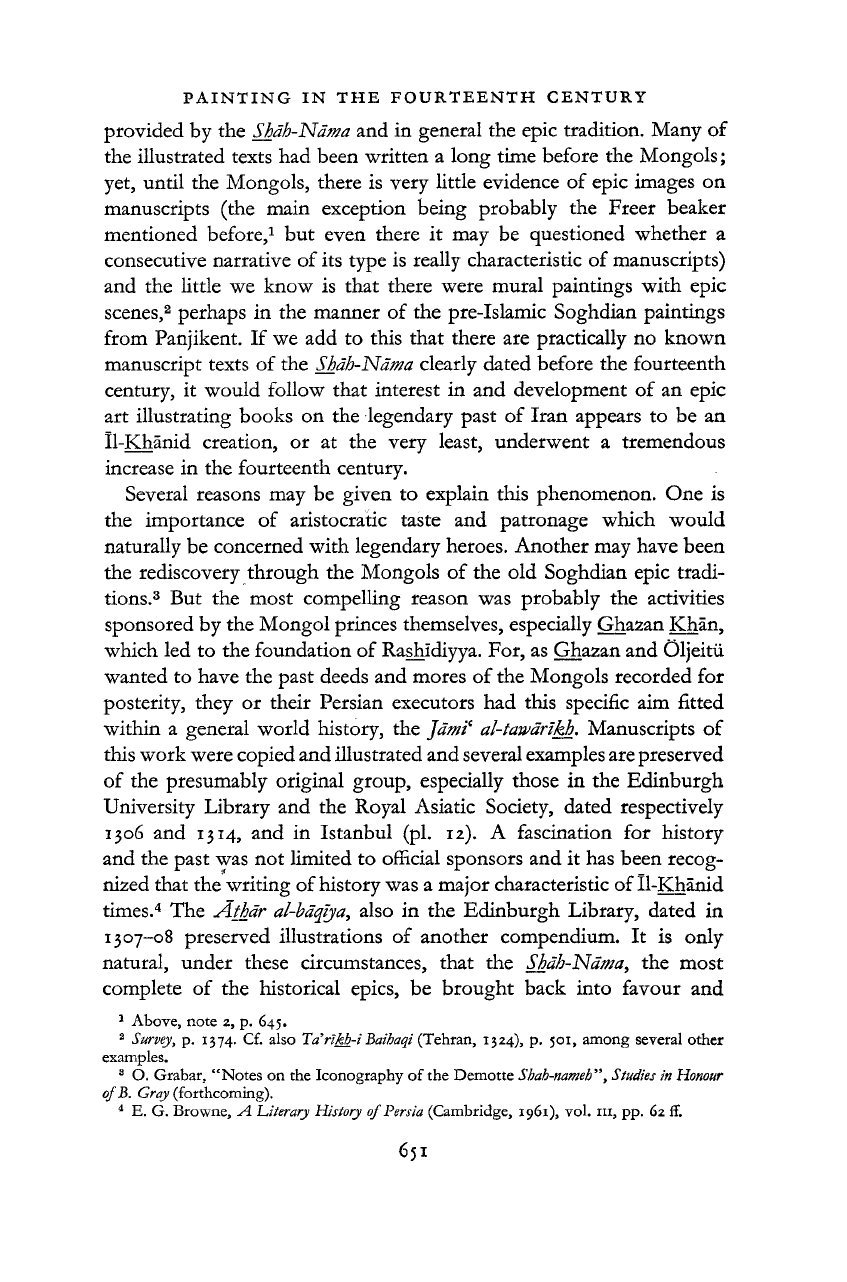
PAINTING IN THE FOURTEENTH CENTUUY
651
provided
by the Shdh-Ndma and in general the epic tradition. Many of
the illustrated texts had been written a long time before the Mongols;
yet,
until the Mongols, there is very little evidence of epic images on
manuscripts (the main exception being probably the Freer beaker
mentioned before,
1
but even there it may be questioned whether a
consecutive
narrative of its type is really characteristic of manuscripts)
and the little we know is
that
there were mural paintings with epic
scenes,
2
perhaps in the manner of the pre-Islamic Soghdian paintings
from
Panjikent. If we add to this
that
there are practically no known
manuscript texts of the Shdh-Ndma clearly dated before the fourteenth
century, it would
follow
that
interest in and development of an epic
art illustrating books on the legendary past of
Iran
appears to be an
Il-Khanid
creation, or at the very least, underwent a tremendous
increase in the fourteenth century.
Several
reasons may be given to explain this phenomenon. One is
the importance of aristocratic taste and patronage which would
naturally be concerned with legendary heroes. Another may have been
the rediscovery through the Mongols of the old Soghdian epic tradi-
tions,
3
But the most compelling reason was probably the activities
sponsored by the Mongol princes themselves, especially Ghazan Khan,
which
led to the foundation of
Rashidiyya.
For, as Ghazan and Oljeitu
wanted to have the past deeds and mores of the Mongols recorded for
posterity, they or their Persian executors had this specific aim fitted
within
a general world history, the
J
ami*
al-tawdrikh. Manuscripts of
this work were copied and illustrated and several examples are preserved
of
the presumably original group, especially those in the Edinburgh
University
Library and the Royal Asiatic Society, dated respectively
1306
and 1314, and in Istanbul (pi. 12). A fascination for history
and the past was not limited to
official
sponsors and it has been recog-
nized
that
the writing of history was a major characteristic of Il-Khanid
times.
4
The Athdr
al-bdqiya,
also in the Edinburgh Library, dated in
1307-08 preserved illustrations of another compendium. It is only
natural, under these circumstances,
that
the Shdh-Ndma, the most
complete of the historical epics, be brought back into favour and
1
Above,
note
2, p. 645.
2
Survey,
p. 1374. Cf.
also
Ta'rifeh-i
Baihaqi
(Tehran. 1324),
p. 501,
among
several
other
examples.
3
O. Grabar,
"Notes
on the
Iconography
of the
Demotte
Shab-nameh",
Studies
in
Honour
o/B.
Gray
(forthcoming).
4
E. G.
Browne,
A
Literary
History
of
Persia
(Cambridge,
1961), vol. in, pp. 62 ff.
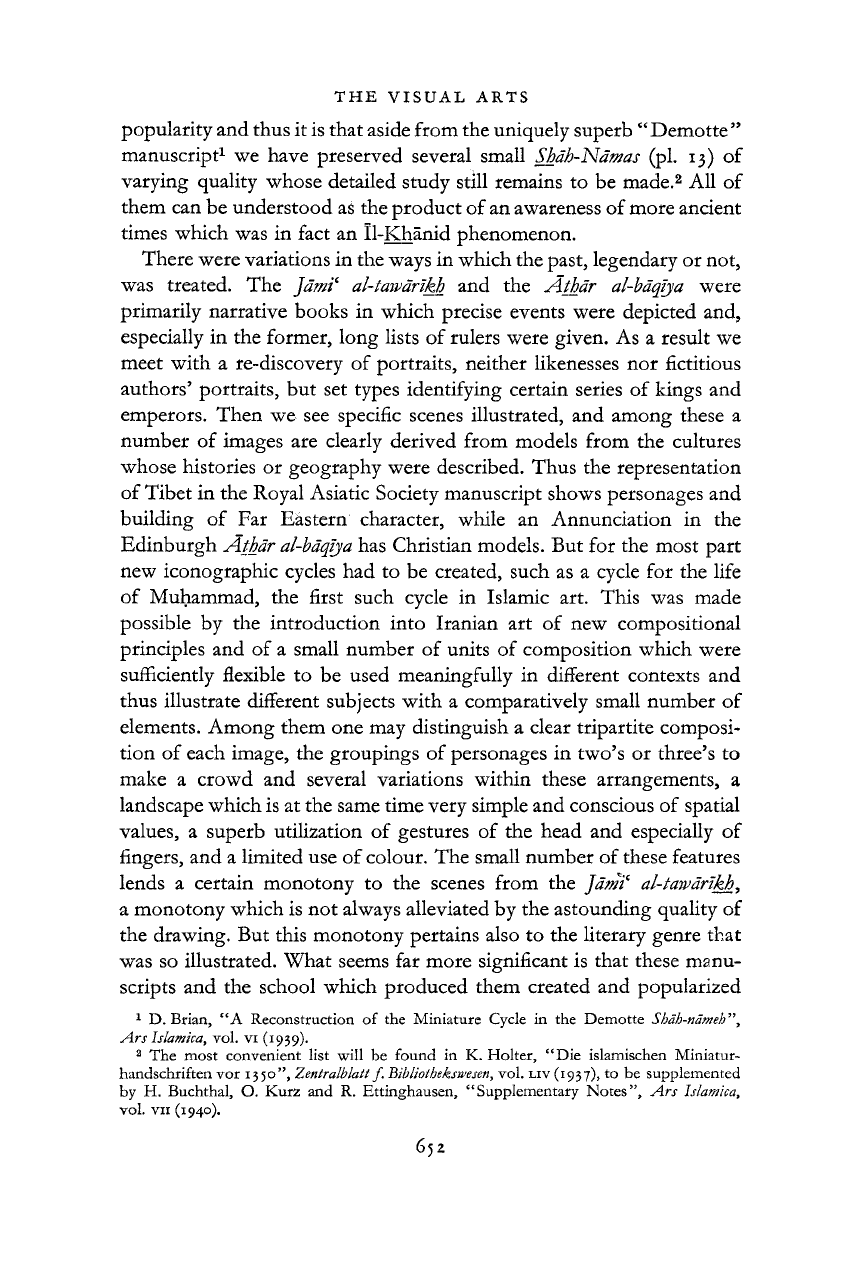
THE VISUAL ARTS
652
popularity and
thus
it is
that
aside from the uniquely superb "Demotte"
manuscript
1
we have preserved several small Shah-Nam as (pi. 13) of
varying
quality whose detailed study still remains to be made.
2
All of
them can be understood as the product of an awareness of more ancient
times which was in fact an ll-Khanid phenomenon.
There were variations in the ways in which the past, legendary or not,
was
treated. The Jam? al-taivdrikh and the Athdr al-bdqiya were
primarily narrative books in which precise events were depicted and,
especially
in the former, long lists of rulers were given. As a result we
meet with a re-discovery of portraits, neither likenesses nor fictitious
authors' portraits, but set types identifying certain series of kings and
emperors. Then we see specific scenes illustrated, and among these a
number of images are clearly derived from models from the cultures
whose
histories or geography were described. Thus the representation
of
Tibet in the Royal Asiatic Society manuscript shows personages and
building
of Far Eastern character, while an Annunciation in the
Edinburgh Athdr
al-bdqiya
has Christian models. But for the most
part
new
iconographic
cycles
had to be created, such as a
cycle
for the
life
of
Muhammad, the first such
cycle
in Islamic art. This was made
possible
by the introduction into Iranian art of new compositional
principles and of a small number of units of composition which were
sufficiently
flexible to be used meaningfully in different contexts and
thus
illustrate different subjects with a comparatively small number of
elements. Among them one may distinguish a clear
tripartite
composi-
tion of each image, the groupings of personages in two's or three's to
make a crowd and several variations within these arrangements, a
landscape which is at the same time very simple and conscious of spatial
values,
a superb utilization of gestures of the head and especially of
fingers, and a limited use of colour. The small number of these features
lends a certain monotony to the scenes from the Jam? al-tawdrikh,
a monotony which is not always alleviated by the astounding quality of
the drawing. But this monotony pertains also to the literary genre
that
was
so illustrated. What seems far more significant is
that
these manu-
scripts and the school which produced them created and popularized
1
D.
Brian,
"A
Reconstruction
of the
Miniature
Cycle in the
Demotte
Shah-ndmeh",
ArsIslamica,
vol. vi
(1939).
2
The
most
convenient
list
will
be
found
in K.
Holter,
"Die
islamischen
Miniatur-
handschriften
vor
1350",
Zentralblatt
f.
Bibliothekswesen,
vol.
LIV
(1937),
to be
supplemented
by H.
Buchthal,
O. Kurz and R.
Ettinghausen,
"Supplementary
Notes",
Ars
Islamica,
vol. vii
(1940).
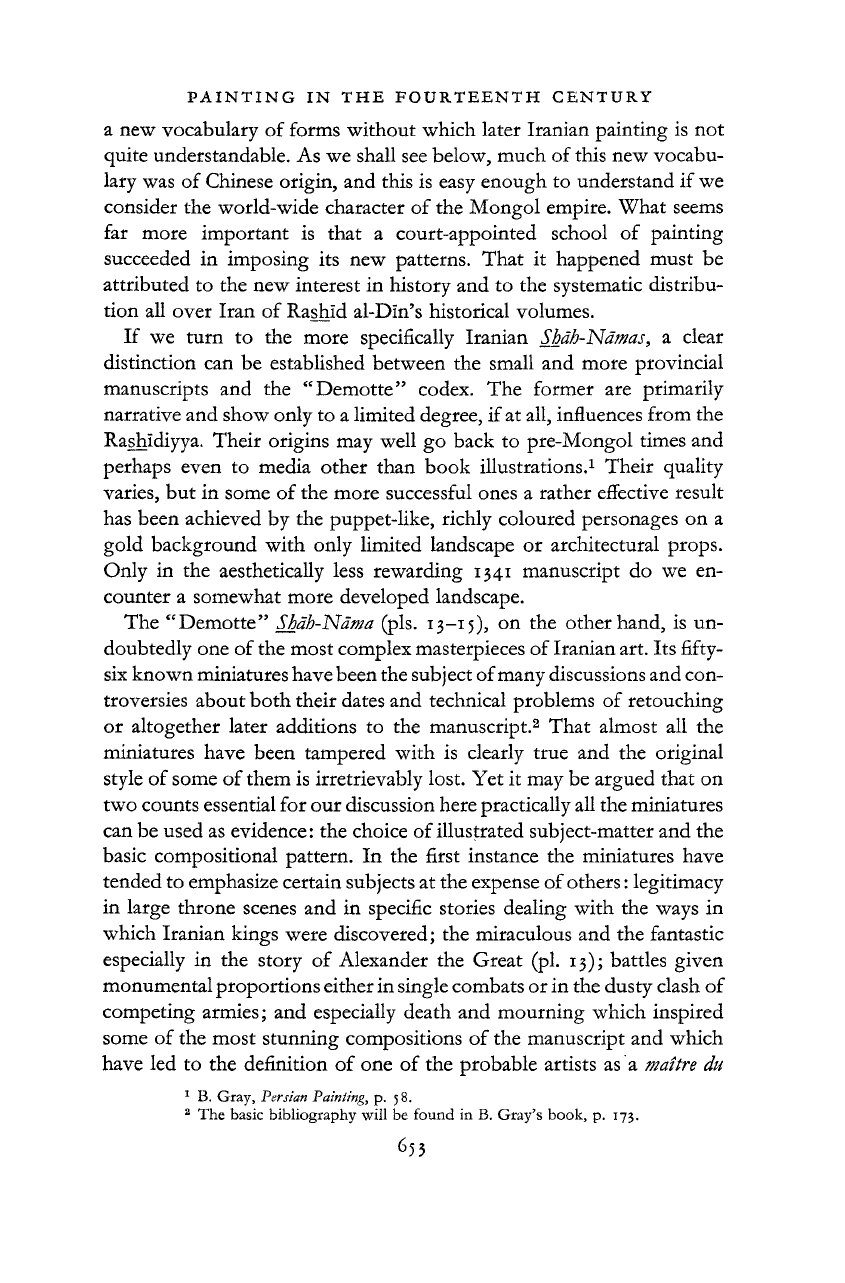
PAINTING IN THE FOURTEENTH CENTURY
653
a new vocabulary of forms without which later Iranian painting is not
quite understandable. As we shall see below, much of this new vocabu-
lary was of Chinese origin, and this is easy enough to understand if we
consider the world-wide character of the Mongol empire. What seems
far more important is
that
a court-appointed school of painting
succeeded in imposing its new patterns. That it happened must be
attributed to the new interest in history and to the systematic distribu-
tion all over
Iran
of Rashid al-Din's historical volumes.
If
we
turn
to the more specifically Iranian Shah-Ndmas, a clear
distinction can be established between the small and more provincial
manuscripts and the "Demotte" codex. The former are primarily
narrative and show only to a limited degree, if at all, influences from the
Rashidiyya.
Their origins may
well
go back to pre-Mongol times and
perhaps even to media other
than
book illustrations.
1
Their quality
varies,
but in some of the more successful ones a
rather
effective
result
has been achieved by the puppet-like, richly coloured personages on a
gold
background with only limited landscape or architectural props.
Only
in the aesthetically less rewarding 1341 manuscript do we en-
counter a somewhat more developed landscape.
The
"Demotte" Shdh-Ndma (pis.
13-15),
on the other hand, is un-
doubtedly one of the most complex masterpieces of Iranian art. Its
fifty-
six
known miniatures have been the subject
of
many discussions and con-
troversies about both their dates and technical problems of retouching
or altogether later additions to the manuscript.
2
That almost all the
miniatures have been tampered with is clearly
true
and the original
style
of some of them is irretrievably lost. Yet it may be argued
that
on
two
counts essential for our discussion here practically all the miniatures
can be used as evidence: the choice of illustrated subject-matter and the
basic compositional
pattern.
In the first instance the miniatures have
tended to emphasize certain subjects at the expense of others: legitimacy
in large
throne
scenes and in specific stories dealing with the
ways
in
which
Iranian kings were discovered; the miraculous and the fantastic
especially
in the story of Alexander the Great (pi. 13); battles
given
monumental proportions either in single combats or in the dusty clash of
competing armies; and especially death and mourning which inspired
some of the most stunning compositions of the manuscript and which
have led to the definition of one of the probable artists as a maitre du
1
B. Gray,
Persian
Painting,
p. 58.
2
The
basic
bibliography
will
be
found
in B. Gray's
book,
p. 173.
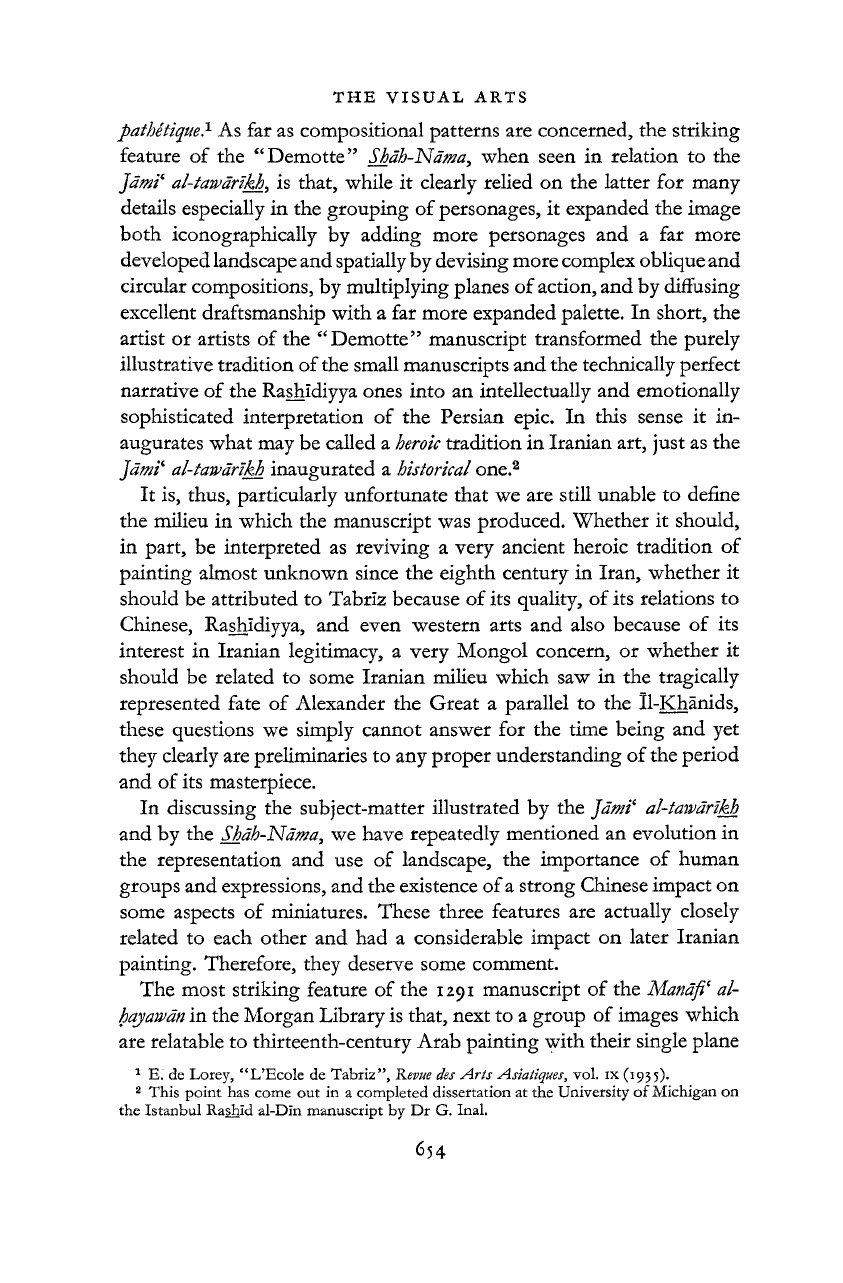
THE VISUAL ARTS
654
pathétique?-
As far as compositional
patterns
are concerned, the striking
feature of the "Demotte" Shâh-Nâma, when seen in relation to the
Jam? al-tawdrikh, is
that,
while it clearly relied on the latter for many
details especially in the grouping of personages, it expanded the image
both iconographically by adding more personages and a far more
developed
landscape and spatially by devising more complex oblique and
circular compositions, by multiplying planes of action, and by diffusing
excellent
draftsmanship with a far more expanded palette. In short, the
artist or artists of the "Demotte" manuscript transformed the purely
illustrative tradition of the small manuscripts and the technically perfect
narrative of the Rashidiyya ones into an intellectually and emotionally
sophisticated interpretation of the Persian epic. In this sense it in-
augurates what may be called a
heroic
tradition in Iranian art, just as the
Jam?
al-tawârikh
inaugurated a
historical
one.
2
It is, thus, particularly unfortunate
that
we are still unable to define
the milieu in which the manuscript was produced. Whether it should,
in
part,
be interpreted as reviving a very ancient heroic tradition of
painting almost unknown since the eighth century in
Iran,
whether it
should be attributed to Tabriz because of its quality, of its relations to
Chinese,
Rashidiyya, and even western
arts
and also because of its
interest in Iranian legitimacy, a very Mongol concern, or whether it
should be related to some Iranian milieu which saw in the tragically
represented fate of Alexander the Great a parallel to the
Il-Khânids,
these questions we simply cannot answer for the time being and yet
they clearly are preliminaries to any proper understanding of the period
and of its masterpiece.
In discussing the subject-matter illustrated by the Jam?
al-tawârikh
and by the Shâh-Nâma, we have repeatedly mentioned an evolution in
the representation and use of landscape, the importance of human
groups and expressions, and the existence
of
a strong Chinese impact on
some aspects of miniatures. These three features are actually
closely
related to each other and had a considerable impact on later Iranian
painting. Therefore, they deserve some comment.
The
most striking feature of the 1291 manuscript of the
Manafi*
al-
io
ay aw
ân
in the Morgan Library is
that,
next to a group of images which
are relatable to thirteenth-century Arab painting with their single plane
1
E. de
Lorey,
"L'Ecole
de Tabriz",
Revue
des
Arts
Asiatiques,
vol. ix
(1935).
2
This
point
has
come
out in a
completed
dissertation
at the
University
of
Michigan
on
the
Istanbul Rashid
al-Din
manuscript
by Dr G.
Inal.
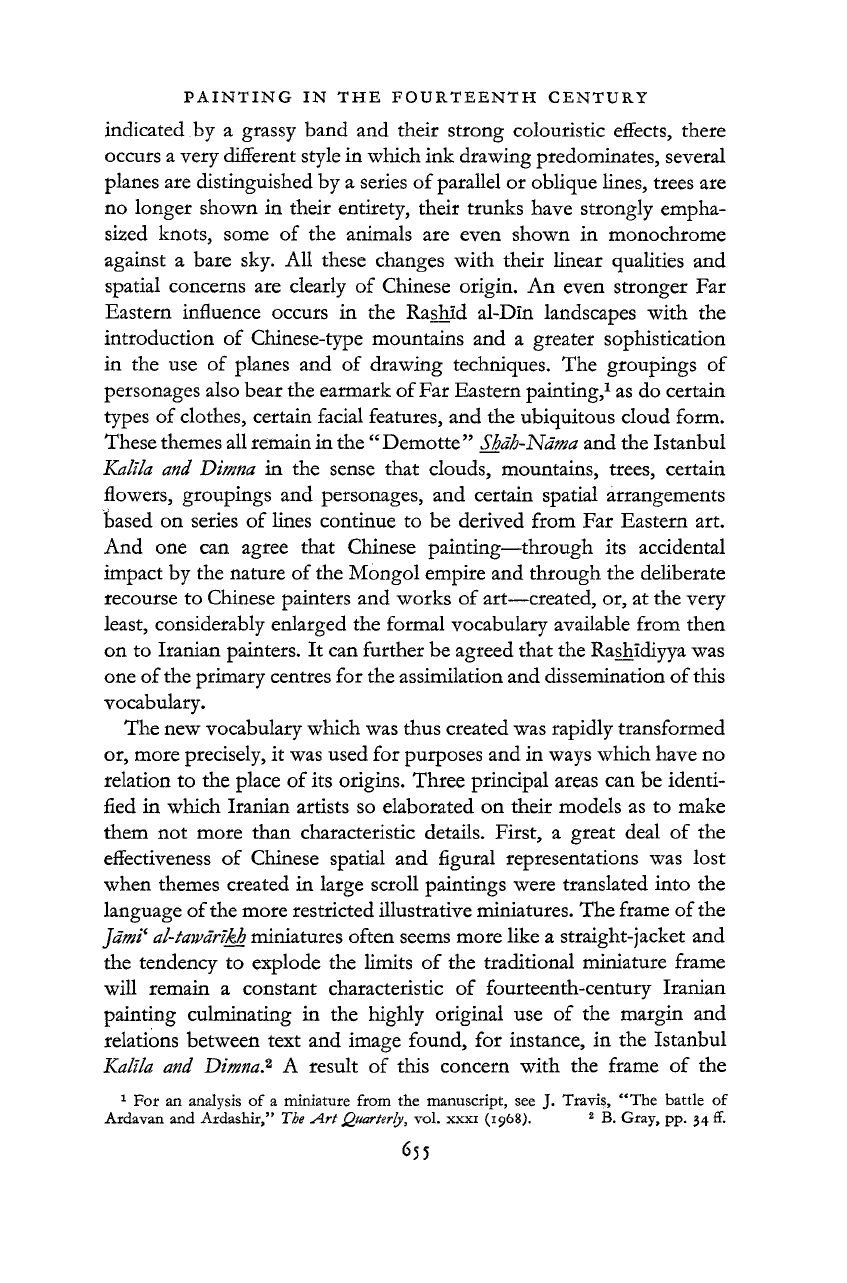
PAINTING IN THE FOURTEENTH CENTURY
655
indicated by a grassy band and their strong colouristic
effects,
there
occurs
a very different style in which ink drawing predominates, several
planes are distinguished by a series of parallel or oblique lines, trees are
no longer shown in their entirety, their trunks have strongly empha-
sized
knots, some of the animals are even shown in monochrome
against a bare sky. All these changes with their linear qualities and
spatial concerns are clearly of Chinese origin. An even stronger Far
Eastern influence occurs in the Rashid al-Dln landscapes with the
introduction of Chinese-type mountains and a greater sophistication
in the use of planes and of drawing techniques. The groupings of
personages also bear the earmark of Far Eastern painting,
1
as do certain
types
of clothes, certain facial features, and the ubiquitous cloud form.
These
themes all remain in the "Demotte" Shah-Nam
a
and the Istanbul
Kalila
and Dimna in the sense
that
clouds, mountains, trees, certain
flowers,
groupings and personages, and certain spatial arrangements
based on series of lines continue to be derived from Far Eastern art.
And
one can agree
that
Chinese painting—through its accidental
impact by the
nature
of the Mongol empire and through the deliberate
recourse to Chinese painters and works of art—created, or, at the very
least, considerably enlarged the formal vocabulary available from then
on to Iranian painters. It can further be agreed
that
the Rashidiyya was
one of the primary centres for the assimilation and dissemination of this
vocabulary.
The
new vocabulary which was
thus
created was rapidly transformed
or, more precisely, it was used for purposes and in
ways
which have no
relation to the place of its origins. Three principal areas can be identi-
fied in which Iranian artists so elaborated on their models as to make
them not more
than
characteristic details. First, a great deal of the
effectiveness
of Chinese spatial and figural representations was lost
when
themes created in large scroll paintings were translated into the
language
of the more restricted illustrative miniatures. The frame of the
Jam?
al-tawarikh
miniatures often seems more like a straight-jacket and
the tendency to explode the limits of the traditional miniature frame
will
remain a constant characteristic of fourteenth-century Iranian
painting culminating in the highly original use of the margin and
relations between text and image found, for instance, in the Istanbul
Kalila
and Dimna?
1
A result of this concern with the frame of the
1
For an
analysis
of a
miniature
from
the
manuscript,
see J. Travis, "The
battle
of
Ardavan
and
Ardashir,"
The Art
Quarterly,
vol.
xxxi
(1968).
2
B. Gray, pp. 34 ff.
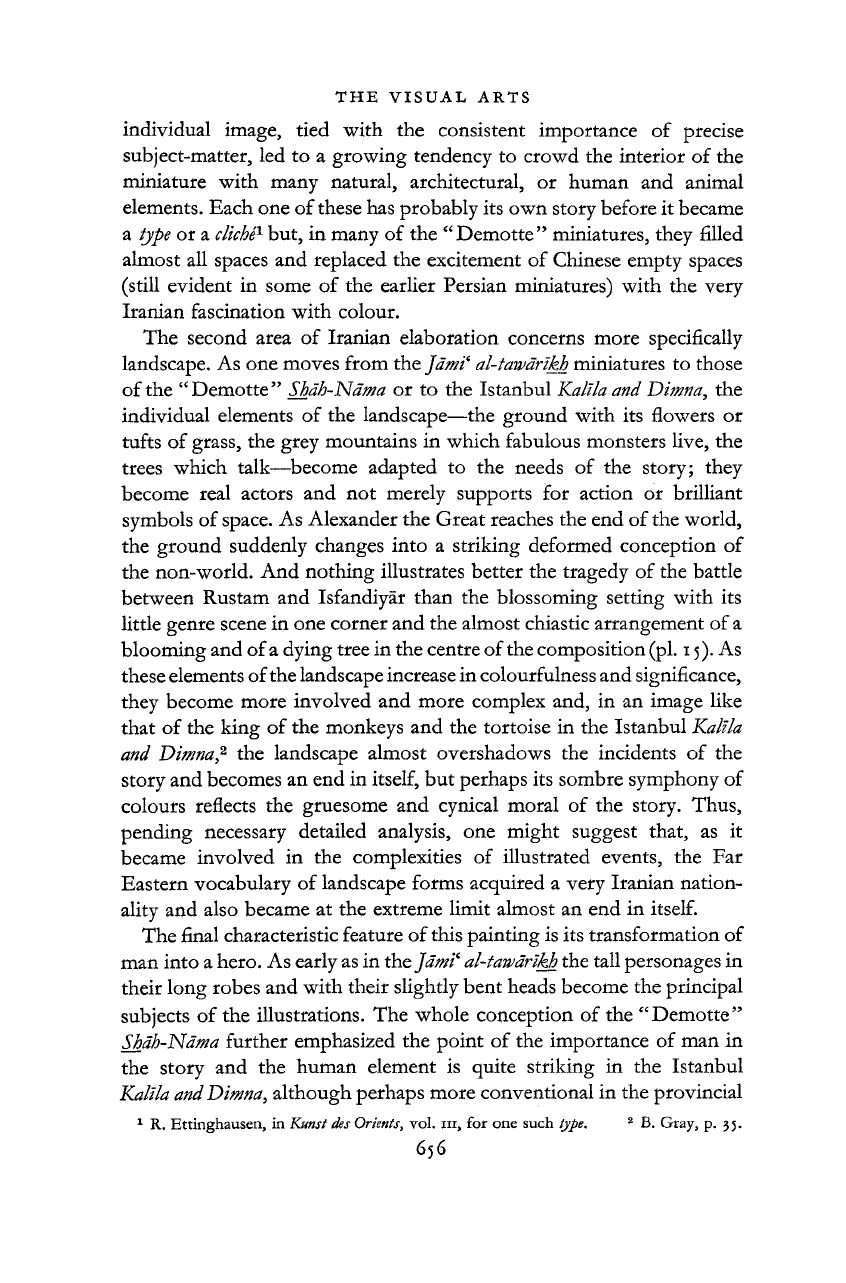
THE VISUAL ARTS
individual
image, tied with the consistent importance of precise
subject-matter, led to a growing tendency to crowd the interior of the
miniature with many natural, architectural, or human and animal
elements. Each one of these has probably its own story before it became
a
type
or a
cliche
1
but, in many of the "Demotte" miniatures, they
filled
almost all spaces and replaced the excitement of Chinese empty spaces
(still
evident in some of the earlier Persian miniatures) with the very
Iranian
fascination with colour.
The
second area of
Iranian
elaboration concerns more specifically
landscape. As one moves from the
Jam?
al-tawarikh
miniatures to those
of
the "Demotte" Shdh-Ndma or to the Istanbul Kalila and Dimna, the
individual
elements of the landscape—the ground with its flowers or
tufts of grass, the grey mountains in which fabulous monsters
live,
the
trees which talk—become adapted to the needs of the story; they
become
real actors and not merely supports for action or brilliant
symbols
of
space.
As Alexander the Great reaches the end of the world,
the ground suddenly changes into a striking deformed conception of
the non-world. And nothing illustrates better the tragedy of the battle
between
Rustam and Isfandiyar
than
the blossoming setting with its
little genre scene in one corner and the almost chiastic arrangement of a
blooming
and
of
a dying
tree
in the centre
of
the composition
(pi.
15).
As
these elements
of
the landscape increase in colourfulness and significance,
they become more involved and more complex and, in an image like
that
of the king of the monkeys and the tortoise in the Istanbul Kalila
and Dimna
2
the landscape almost overshadows the incidents of the
story and becomes an end in itself, but perhaps its sombre symphony of
colours
reflects the gruesome and cynical moral of the story. Thus,
pending necessary detailed analysis, one might suggest
that,
as it
became involved in the complexities of illustrated events, the Far
Eastern vocabulary of landscape forms acquired a very
Iranian
nation-
ality
and also became at the extreme limit almost an end in itself.
The
final characteristic feature of this painting is its transformation of
man into a hero. As early as in the
Jam?
al-tawarikh
the tall personages in
their long robes and with their slightly bent heads become the principal
subjects of the illustrations. The whole conception of the "Demotte"
Shdh-Ndma further emphasized the point of the importance of man in
the story and the human element is quite striking in the Istanbul
Kalila
and
Dimna, although perhaps more conventional in the provincial
1
R.
Ettinghausen,
in
Kunst
des
Orients,
vol. in, for one
such
type.
2
B. Gray, p. 35.
656
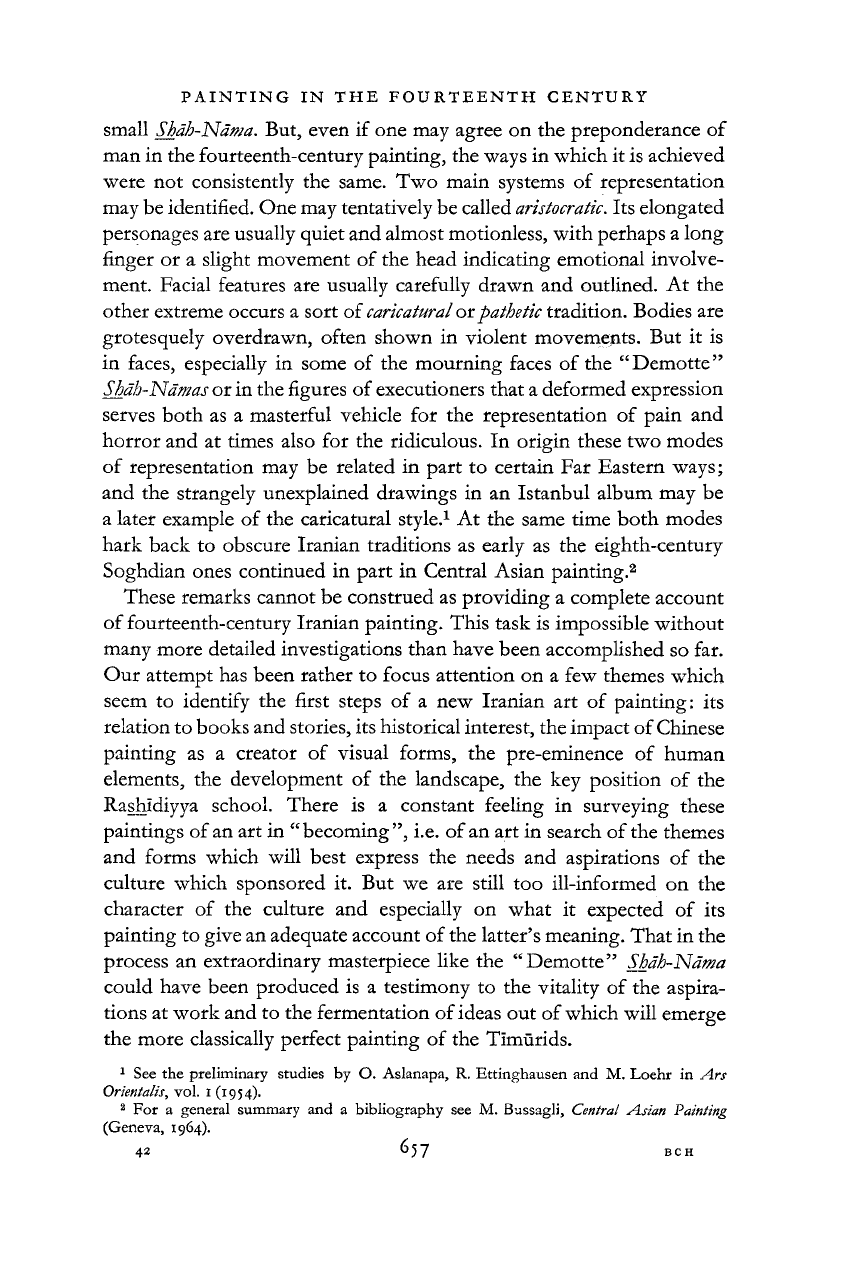
PAINTING IN THE FOURTEENTH CENTURY
small Shdh-Ndma. But, even if one may agree on the preponderance of
man in the fourteenth-century painting, the
ways
in which it is achieved
were
not consistently the same. Two main systems of representation
may be identified. One may tentatively be called
aristocratic.
Its elongated
personages are usually quiet and almost motionless, with perhaps a long
finger or a slight movement of the head indicating emotional
involve-
ment. Facial features are usually carefully drawn and outlined. At the
other extreme occurs a sort of
caricatural
or pathetic tradition. Bodies are
grotesquely overdrawn, often shown in violent movements. But it is
in
faces,
especially in some of the mourning faces of the "Demotte"
Shdh-Ndmas
or in the figures of executioners
that
a deformed expression
serves both as a masterful vehicle for the representation of pain and
horror
and at times also for the ridiculous. In origin these two modes
of
representation may be related in
part
to certain Far Eastern
ways;
and the strangely unexplained drawings in an Istanbul album may be
a later example of the caricatural style.
1
At the same time both modes
hark back to obscure
Iranian
traditions as early as the eighth-century
Soghdian ones continued in
part
in Central
Asian
painting.
2
These
remarks cannot be construed as providing a complete account
of
fourteenth-century
Iranian
painting. This task is impossible without
many more detailed investigations
than
have been accomplished so far.
Our
attempt
has been
rather
to focus attention on a few themes which
seem to identify the first steps of a new
Iranian
art of painting: its
relation to books and stories, its historical interest, the impact of Chinese
painting as a creator of visual forms, the pre-eminence of human
elements, the development of the landscape, the key position of the
Rashidiyya
school. There is a constant feeling in surveying these
paintings of an art in "becoming", i.e. of an art in search of the themes
and forms which
will
best express the needs and aspirations of the
culture which sponsored it. But we are still too ill-informed on the
character of the culture and especially on what it expected of its
painting to
give
an adequate account of the latter's meaning. That in the
process an extraordinary masterpiece like the "Demotte" Shdh-Ndma
could
have been produced is a testimony to the vitality of the aspira-
tions at work and to the fermentation of ideas out of which
will
emerge
the more classically perfect painting of the Timürids.
1
See the
preliminary
studies
by O.
Aslanapa,
R.
Ettinghausen
and M.
Loehr
in Ars
Orientalis,
vol. i
(1954).
2
For a
general
summary
and a
bibliography
see M.
Bussagli,
Central
Asian
Painting
(Geneva,
1964).
42
657
BCH
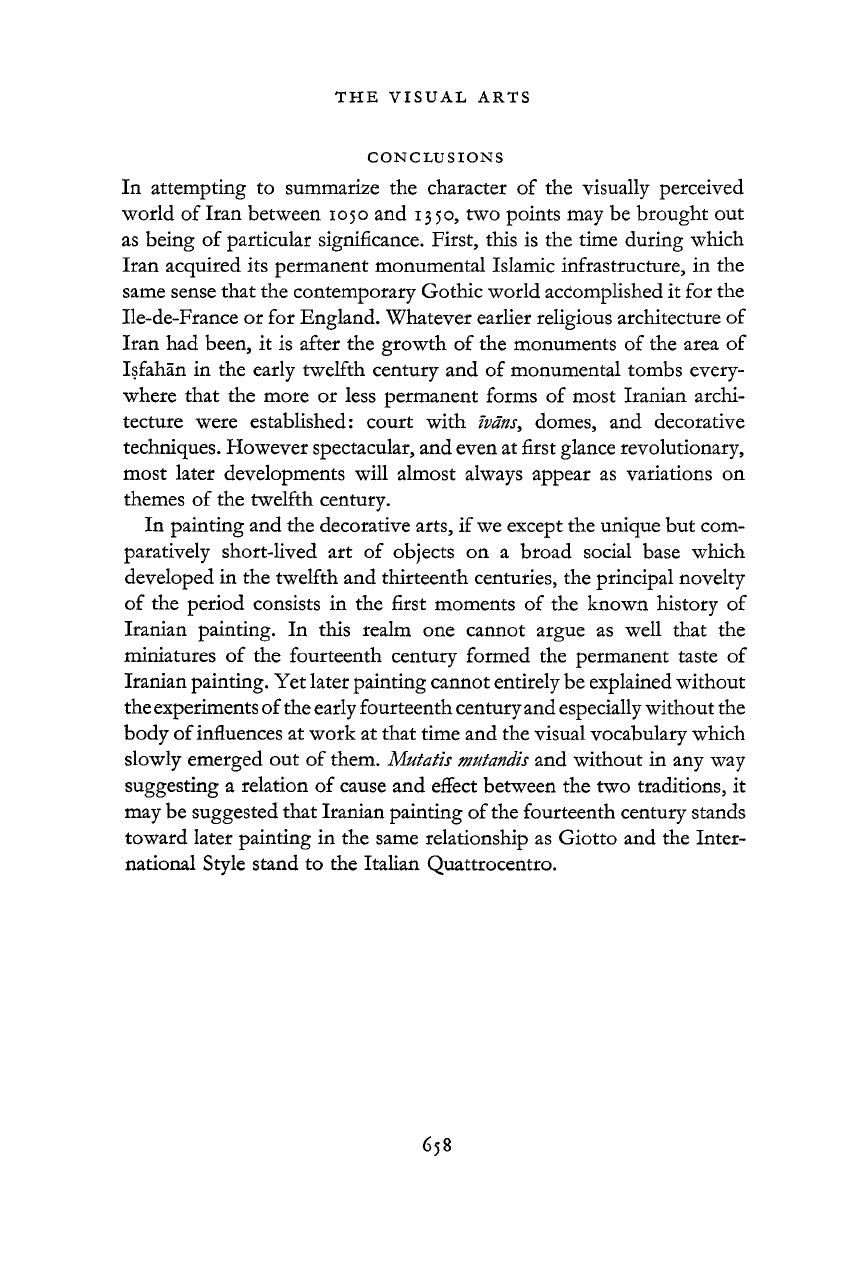
THE
VISUAL
ARTS
CONCLUSIONS
In attempting to summarize the character of the visually perceived
world
of
Iran
between 1050 and 1350, two points may be brought out
as being of particular significance. First, this is the time during which
Iran
acquired its permanent monumental Islamic infrastructure, in the
same sense
that
the contemporary Gothic world accomplished it for the
Ile-de-France or for England. Whatever earlier religious architecture of
Iran
had been, it is after the growth of the monuments of the area of
Isfahan in the early twelfth century and of monumental tombs every-
where
that
the more or less permanent forms of most Iranian archi-
tecture were established: court with Ivans, domes, and decorative
techniques. However spectacular, and even at first glance revolutionary,
most later developments
will
almost always appear as variations on
themes of the twelfth century.
In painting and the decorative arts, if we except the unique but com-
paratively
short-lived art of objects on a broad social base which
developed
in the twelfth and thirteenth centuries, the principal novelty
of
the period consists in the first moments of the known history of
Iranian painting. In this realm one cannot argue as
well
that
the
miniatures of the fourteenth century formed the permanent taste of
Iranian painting. Yet later painting cannot entirely be explained without
the experiments
of
the early fourteenth century and
especially
without the
body
of influences at work at
that
time and the visual vocabulary which
slowly
emerged out of them. Mutatis
mutandis
and without in any way
suggesting
a relation of cause and
effect
between the two traditions, it
may
be suggested
that
Iranian painting of the fourteenth century stands
toward later painting in the same relationship as Giotto and the
Inter-
national
Style
stand to the Italian Quattrocentro.
658
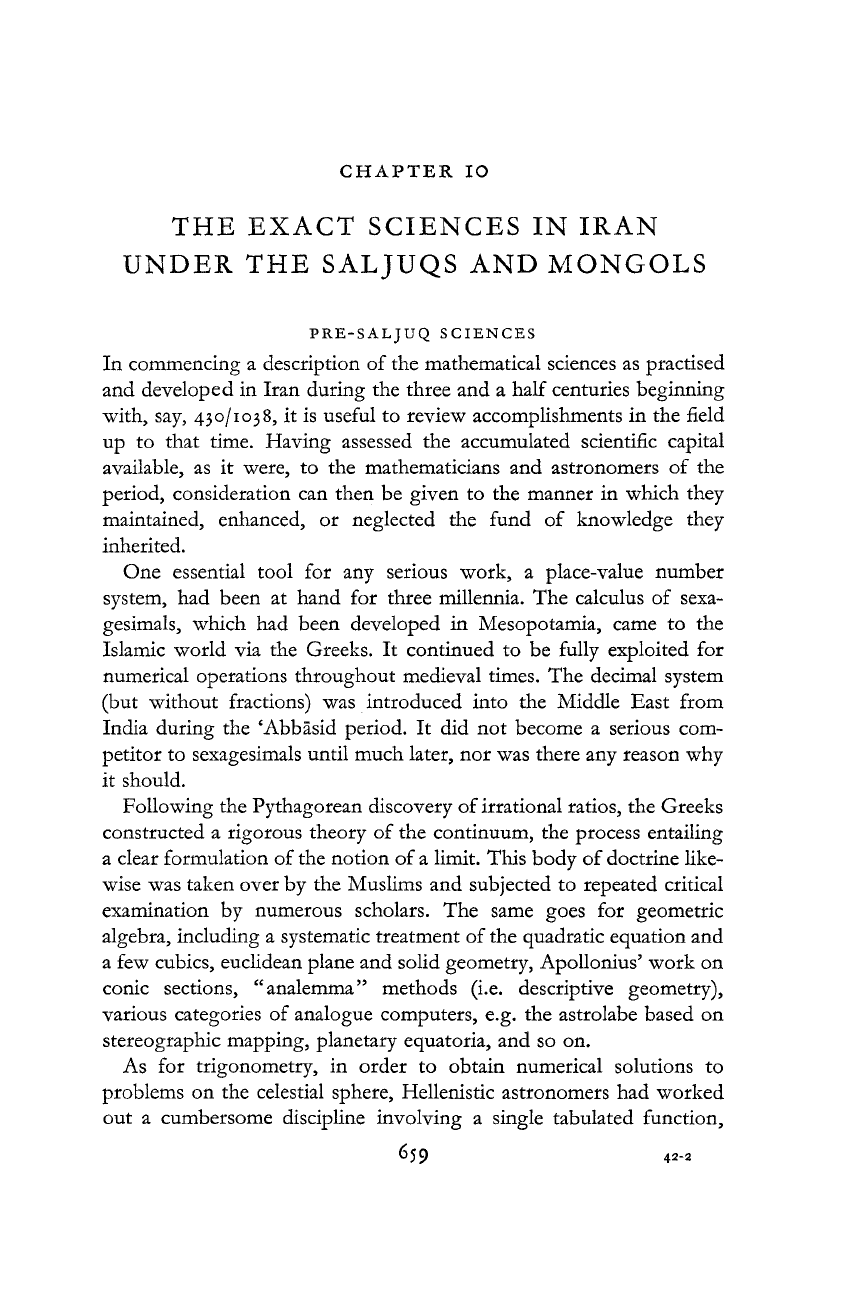
CHAPTER
IO
THE EXACT
SCIENCES
IN
IRAN
UNDER
THE SALJUQS AND
MONGOLS
PRE-SALJUQ SCIENCES
In commencing a description of the mathematical sciences as practised
and developed in
Iran
during the
three
and a half centuries beginning
with,
say, 430/1038, it is useful to review accomplishments in the field
up to
that
time. Having assessed the accumulated scientific capital
available,
as it were, to the mathematicians and astronomers of the
period, consideration can
then
be given to the
manner
in which they
maintained, enhanced, or neglected the fund of knowledge they
inherited.
One
essential tool for any serious work, a place-value number
system,
had been at
hand
for
three
millennia. The calculus of sexa-
gesimals,
which had been developed in Mesopotamia, came to the
Islamic world via the Greeks. It continued to be fully exploited for
numerical operations throughout medieval times. The decimal system
(but without fractions) was introduced into the Middle East from
India during the 'Abbasid period. It did not become a serious com-
petitor to sexagesimals until much later, nor was
there
any reason why
it should.
Following
the Pythagorean discovery of irrational ratios, the Greeks
constructed a rigorous theory of the continuum, the process entailing
a clear formulation of the notion of a limit. This body of doctrine like-
wise
was taken over by the Muslims and subjected to repeated critical
examination by numerous scholars. The same goes for geometric
algebra,
including a systematic
treatment
of the quadratic equation and
a few cubics, euclidean plane and solid geometry, Apollonius' work on
conic
sections, "analemma" methods (i.e. descriptive geometry),
various categories of analogue computers, e.g. the astrolabe based on
stereographic mapping, planetary equatoria, and so on.
As
for trigonometry, in order to obtain numerical solutions to
problems on the celestial sphere, Hellenistic astronomers had worked
out a cumbersome discipline involving a single tabulated function,
659
42-2
